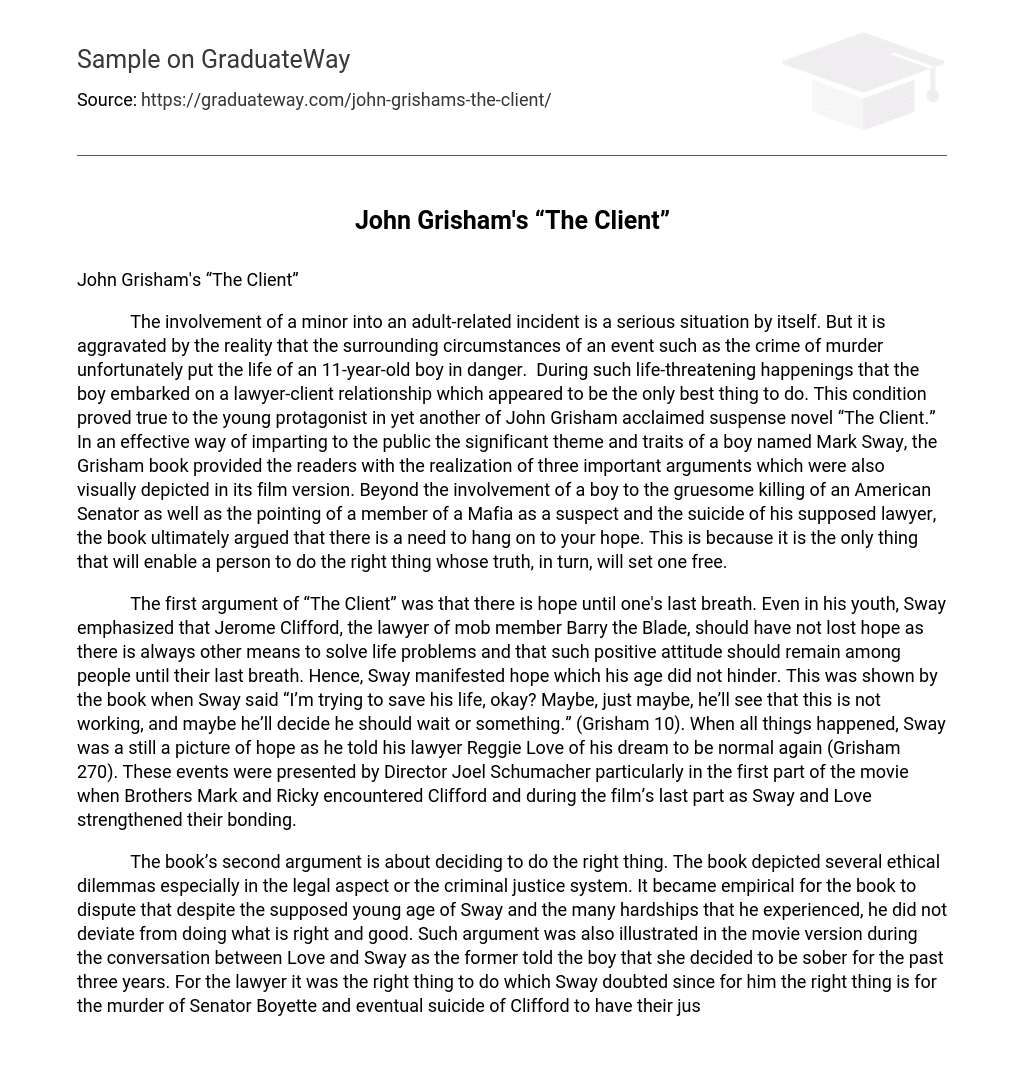The involvement of a minor into an adult-related incident is a serious situation by itself. But it is aggravated by the reality that the surrounding circumstances of an event such as the crime of murder unfortunately put the life of an 11-year-old boy in danger. During such life-threatening happenings that the boy embarked on a lawyer-client relationship which appeared to be the only best thing to do. This condition proved true to the young protagonist in yet another of John Grisham acclaimed suspense novel “The Client.” In an effective way of imparting to the public the significant theme and traits of a boy named Mark Sway, the Grisham book provided the readers with the realization of three important arguments which were also visually depicted in its film version. Beyond the involvement of a boy to the gruesome killing of an American Senator as well as the pointing of a member of a Mafia as a suspect and the suicide of his supposed lawyer, the book ultimately argued that there is a need to hang on to your hope. This is because it is the only thing that will enable a person to do the right thing whose truth, in turn, will set one free.
The first argument of “The Client” was that there is hope until one’s last breath. Even in his youth, Sway emphasized that Jerome Clifford, the lawyer of mob member Barry the Blade, should have not lost hope as there is always other means to solve life problems and that such positive attitude should remain among people until their last breath. Hence, Sway manifested hope which his age did not hinder. This was shown by the book when Sway said “I’m trying to save his life, okay? Maybe, just maybe, he’ll see that this is not working, and maybe he’ll decide he should wait or something.” (Grisham 10). When all things happened, Sway was a still a picture of hope as he told his lawyer Reggie Love of his dream to be normal again (Grisham 270). These events were presented by Director Joel Schumacher particularly in the first part of the movie when Brothers Mark and Ricky encountered Clifford and during the film’s last part as Sway and Love strengthened their bonding.
The book’s second argument is about deciding to do the right thing. The book depicted several ethical dilemmas especially in the legal aspect or the criminal justice system. It became empirical for the book to dispute that despite the supposed young age of Sway and the many hardships that he experienced, he did not deviate from doing what is right and good. Such argument was also illustrated in the movie version during the conversation between Love and Sway as the former told the boy that she decided to be sober for the past three years. For the lawyer it was the right thing to do which Sway doubted since for him the right thing is for the murder of Senator Boyette and eventual suicide of Clifford to have their justice.
The book’s third argument was simply presented in a way that the readers recognize that truth shall set one free. In the novel, Grisham depicted that Sway saw truth not from real events but from fictional means such as movies and television, both of which serves as his best teachers in recognizing and accepting life realities. Due to the influences imparted by such learning tools, Sway was then assisted in his daily dealings or life experiences. The young hero was able to cautiously and smartly reveal the truth which eventually set him free as well as ended all his burdens and hardships in life. This dispute was specifically shown by the movie clip wherein the lawyer and client tandem revelation of the true location of the body of the Senator paved the way for the murder’s eventual solution. Despite the problems and cat and mouse chase, Sway as the client allowed for the solution of a brutal killing.
The book’s three arguments, as related in the film version, are powerful disputes on life realities including the justice system and moral standards. It is for this part that “The Client,” both the novel and movie, served their respective goal and worth as significant written and visual materials.
Works Cited
Grisham, John. The Client. New York: Brill, 1994.
Schumacher, Joel, dir. The Client. Warner Brothers, 1994.
;





